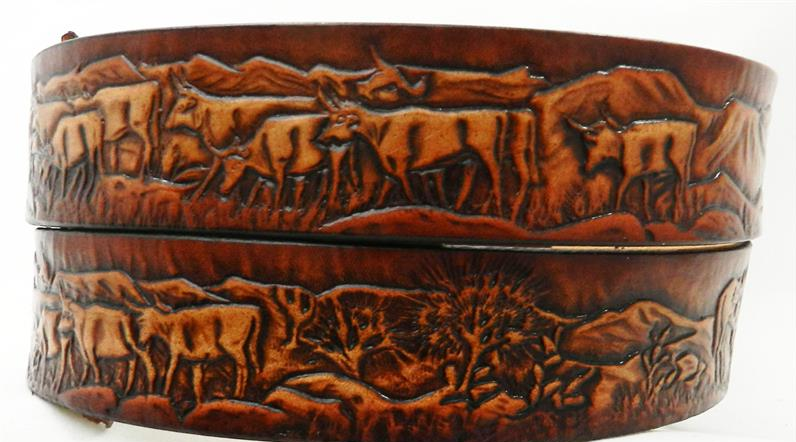In cowboy lingo, these cowboy accessories are called ‘critters.’ The group is the top of a horse’s hindquarters from the tail to the kidney area, while the saddle cuff is used on mules. The leather wrist cuffs protect the wrists from wear and brush and keep the rope from fouling the shirt sleeve. A cut is when a herd of cattle is separated from the rest of the pack. The castrating process separates male animals from their pack.

Description
A cattle round-up belt is a type of livestock transport that gathers a herd of cows, often from a cut circle. This process involves branding or marking the cattle to prevent confusion. Before the advent of deeded lots and Taylor Grazing, cattle were sorted into stud bands. Cattle round-ups have traditionally taken place twice a year, once in the spring to move cattle from their winter residence to the summer pastures and again in the fall (autumn) the opposite way. It can take some time to round up the animals since many smaller herds might stray off, distributing themselves throughout the numerous square kilometers of mountains and woodland. Finding them may turn into a hunt, and collecting them can take a week or more. On a functioning ranch, rounding up takes a lot of effort. Calves must be sorted, separated, marked, and exported; cattle must be branded, neutered, vaccinated, or sent to market; and farms must be maintained and worked on before they can be sold.
History
The cattle round-up was a yearly event, held during late spring or early summer and again in the fall. The first roundup was in the early 1800s when the Jones family came to Texas from Mexico and settled in Kiowa County. Their land holdings totaled 4,428 acres. The cattle would roam the land, requiring annual roundups to separate herds. In addition, cattle owners would brand their calves as their own.
The cattle drive occurred when the United States transitioned from a rural, ranch-based lifestyle to a more urban, industrial society. You can see the history of the cattle round-up belt in various media outlets. Texas had the first cattle roundups and drives, which provided significant economic activity beginning in 1866. They’d journey from the arid dunes of Texas to the lush grassland fields of Kansas. This practice spread throughout America and to other nations where the summers are hot and the winters are frigid, most notably in Argentina and Australia, where the drives are incredibly lengthy. Several settlements were established along the roads and pathways to provide the animals and their handlers with fast food, drink, and rest breaks. Herds may typically move between 10 and 12 miles per day, but if the cattle are exceptionally vigorous, they can travel up to 24 miles daily.
Types
There are many different types of cattle round-up belts. These range from basic, lightweight ones used in the field to more elaborate and intricate devices that help cattlemen maneuver them in the roundup. We’ll also look at how they work. And of course, we’ll also look at the advantages and disadvantages of each.
Cowboys involved
The term “remuda” describes the saddle horse that the cowboy uses on a cattle round-up. Cattle roundups are contested events and include cavvy and cavvietta. The remuda has a variety of duties, including herding and bunching the animals, while the cavvy’s role is to keep the animals under control.



